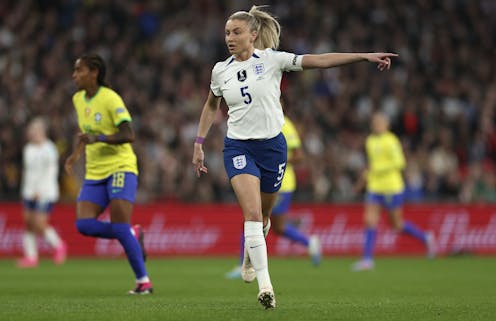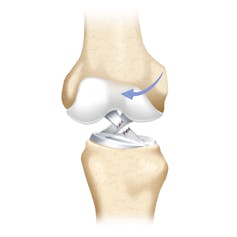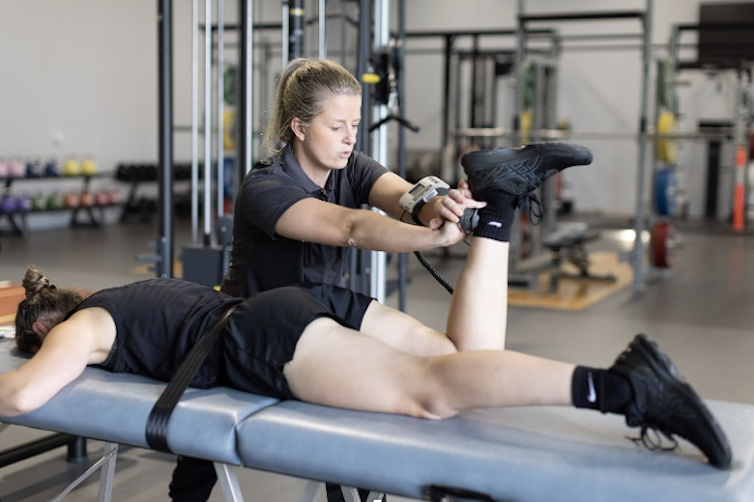Source: The Conversation (Au and NZ) – By Brooke Patterson, Research Fellow, La Trobe University

England women’s soccer captain Leah Williamson and Dutch striker Vivianne Miedema will miss the 2023 FIFA Women’s World Cup, which starts this week, due to ACL injuries.
The anterior cruciate ligament, or ACL, is a piece of tissue like a rope connecting your shin bone to your thigh bone. It’s only 3cm long and 1cm wide but is the most important stabiliser of the knee, alongside your muscles.

Shutterstock
An ACL tear can be a complete or partial. In women’s soccer, they commonly happen during defensive pressing or tackling, or regaining balance on one leg. But more than 80% involve no contact, or indirect contact such as a bump to the shoulder.
Women are more likely to tear their ACL than men playing the same sports, with women soccer players twice as likely to tear their ACL as men.
So how can we reduce the risk of these injuries? And what happens if you injure your ACL?
Why are women more prone to ACL injury?
In the past, factors related to women’s bodies were reported as the main reasons for the higher risk: their anatomy (wider pelvis, slope of the knee bones) or female sex hormones (oestrogen may increase the laxity or looseness of ligaments).
However research has not been able to confirm these factors. We now know the reasons for disparity are complex and multifaceted: women and girls may not develop the same movement skills and muscle function as boys and men in their younger years and across their life.
Other contributing factors include women and girls having fewer opportunities, confidence or support to participate in sports such as football, or activities such as gym training.
Read more:
Female football players are at much higher risk of career-ending ACL injuries – the science on why
How long will you be out for? And what if you’re not an elite athlete?
Most young people (elite and non-elite athletes) will require 12 months off sport to physically recover from an ACL tear. Many will require longer: up to 80% may have ongoing muscle weakness, 40% have ongoing symptoms, and only half return to sport. Women are less likely to return to sport and physical activity than men.
Surgical repair involves taking a small graft from your hamstring, quadriceps, or patellar tendon to replace your ACL.
But if you choose not to have surgery, you can live and be active without an ACL. Research has found non-elite athletes who don’t have surgery can return to the same level of sport and physical function as those who have surgery. (However, this has not been tested yet in elite athletes.)
Whether or not you have surgery, intensive rehabilitation is needed to regain knee muscle strength specific to your sport.
Athletes also need to be psychologically ready to return to sport. Fears of re-injury, lack of confidence and social pressures to return are common, and may negatively affect sport performance and enjoyment.

Author provided
What can be done about the high rates of ACL injuries in women?
Given the high cost of ACL injuries to women athletes, the best thing we can do is to prevent them.
Injury-prevention programs that address movement patterns and muscle function through training and coaching can reduce the risk of non-contact ACL injuries in women by 67%.
Among women’s soccer players, programs with specific warm-up activities (jumping, landing, change of direction, balance) and muscle strengthening (for hip, core and leg) can reduce ACL injuries by 45%.
Read more:
Mark! Kick! Tackle! The reality of fast-tracking women into elite AFL
Players, parents, coaches, schools, and sporting organisations can freely access injury-prevention programs created for soccer (Perform Plus, FIFA11+), Australian football (Prep-to-Play), rugby (Activate), netball (Netball KNEE) and handball (Knäkontroll). The Get Set app is also great for learning about common injuries and injury-prevention exercise for 55 different Olympic sports.
Research suggests ACL injury-prevention programs are effective regardless of whether they are implemented by a coach or a medical professional.
So why are ACL injuries on the rise?
ACL surgeries have increased by 43% in Australia between 2000 and 2015. In Australia, women’s knee injuries have grown by 3% (compared to 1.3% for men), with the highest growth among girls aged 5–14 years (around 10% a year).
While injury-prevention programs are effective when tested in clinical trials, their use by sporting clubs outside of research projects can be as low as 10–20%.
Sporting organisations should make their members aware of the freely available resources, and support and incentivise coaches to use them at least twice per week for 10–15 minutes, as part of team training.
Providing girls and women with equal opportunities and resources will allow them to develop physical and sport-specific skills in their younger years and throughout their life.
Read more:
Is netball actually bad for knees and ankles? What does the research say?
![]()
The authors do not work for, consult, own shares in or receive funding from any company or organisation that would benefit from this article, and have disclosed no relevant affiliations beyond their academic appointment.
– ref. Women soccer players are more likely to tear their ACL than men. Here’s why – and how we can prevent these injuries – https://theconversation.com/women-soccer-players-are-more-likely-to-tear-their-acl-than-men-heres-why-and-how-we-can-prevent-these-injuries-206696








